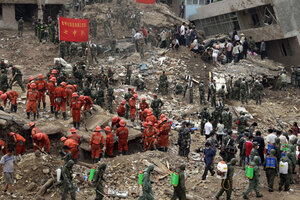China mudslides were predicted 13 years ago
Chinese scientists warned that deforestation in geologically sensitive areas could exacerbate China mudslides.

Rescue workers continue to dig for victims of a mudslide that swept into the town of Zhouqu in Gannan Prefecture in northwestern China's Gansu Province, Aug. 11. Heavy rains Wednesday lashed a remote section of northwestern China as the death toll from weekend flooding that triggered massive landslides jumped to more than 1,000 and the hopes of finding more survivors faded.
Ng Han Guan/AP Photo
Beijing
Monster monsoon rains may have loosened the mud and rock that buried and killed more than 1,000 people in the northwestern Chinese Province of Gansu over the weekend, but the mudslide in Zhouqu was more than a natural disaster.
Official records show that government-run lumber companies cut 313,000 acres of forest from the slopes of Zhouqu county between 1952 and 1990, denuding the geologically vulnerable mountainsides and subjecting them to soil erosion.
Thirteen years ago two Chinese scientists published a paper warning that following “the destruction of the eco-system” in the district, “a rainstorm will carry debris down the gully, destroying farmland, houses, roads, bridges, water facilities, and power systems and causing death and injury.”
That rainstorm struck on Saturday night, Aug. 7, with the catastrophic consequences researchers Ma Dongtao and Qi Long had predicted in 1997 – though one of them is surprised by the scope of the disaster.
“The mudslide was caused by geology, but it was worsened by deforestation,” Dr. Qi says today. “I never expected such a huge slide.”
Highest death toll in more than a decade
Survivors huddled in tents under more rainstorms on Thursday, after a new overnight mudslide blocked a key road into Zhouqu only hours after heavy equipment had begun arriving.
The weekend disaster brought this summer’s nationwide death toll from floods and landslides to more than 3,000, according to official figures. That is the heaviest such loss of life for more than a decade.
The widespread flooding, which has struck northern regions of China that have only rarely known such disaster, follows unusually heavy monsoon rains across Asia. They have been prompted by “La Niña,” a periodic cooling of the surface of the Pacific Ocean, meteorologists say.
The torrential rainfall that fell last Saturday night on Zhouqu was part of the same weather system that has flooded millions of Pakistanis out of their homes in recent days.
Flood control, from the 'great Yu' to communists
Memories of annual floods are deeply embedded in the Chinese psyche. Every schoolchild here learns the legend of “the great Yu,” whose prodigious feats of canal building and drainage ditch digging 4,000 years ago put an end to killer floods on the Yellow River.
Not for long, though. The Yellow River – China’s second longest – has burst its banks repeatedly in the millenniums since, despite the best efforts of dynasty after imperial dynasty to control it. The two deadliest natural disasters in human history were both Yellow River floods, in 1887 and 1931, that between them are estimated to have killed as many as 6 million people.
Dams and other civil engineering works undertaken since the communists took power in 1949 have alleviated the situation over the past six decades, but hardly brought it under control – as this year’s floods have shown. Some 12 million people have been forced from their homes this summer, according to the Ministry of Civil Affairs, and more than $40 billion worth of damage has been done.
China's efficient crisis management
The Chinese authorities have acquitted themselves well in rescue and relief efforts however, according to local experts, maintaining a reputation for efficiency earned during the Sichuan earthquake in 2008.
“Since the SARS outbreak in 2003,” when Beijing drew international condemnation for irresponsibility by trying to conceal and ignore the epidemic, “the government has learned a lot about crisis management and paid a lot of attention to it,” says Peng Zongchao, a crisis response expert at Tsinghua University in Beijing.
“The most important element for the Chinese government,” Professor Peng adds, “is its strong mobilization ability.”
As a centrally controlled system enforcing strict one party discipline, and with the military under the Communist Party’s command, “the government can mobilize social forces and essential resources to respond to emergencies,” Peng says.
“This summer,” he says “we have seen them responding to natural disasters like the floods very quickly.”
IN PICTURES: China floods and landslides
